iPad 4 (Late 2012) Review
by Anand Lal Shimpi on December 6, 2012 4:40 PM ESTDisplay Analysis
The 4th gen iPad retains the same Retina Display as its predecessor. The 9.7-inch 2048 x 1536 display looks just as good as it did earlier this year. Brightness, black levels and contrast are all very good. The real advantage however is color accuracy thanks to Apple's factory calibration on all of its devices with an integrated display.
As with all of Apple's other Retina Displays, software support is made easy through integer scaling. The 2048 x 1536 resolution is an increase of 2x in both dimensions over the standard iPad/iPad mini resolution. App developers simply have to provide 2x scaled assets in order to make the most of the Retina Display. Deciding what image to load (standard res or 2x scaled) is handled automatically, the developer just needs to ensure that it's supplying both sets of images for the best user experience. Games can run either at the panel's native resolution, or run at a non-native offscreen resolution and simply scale up to the panel resolution if the title's performance requirements are too high (more on this later).
All first party apps and most of the 3rd party iPad apps I use on a regular basis are already Retina aware.
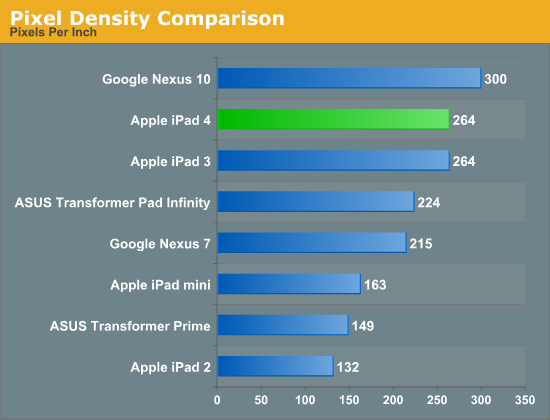
The big advantage the Retina Display offers over other iPads is a much better text reading experience. Individual letters look so much smoother:

I borrowed the paragraph shots below from our iPad mini review to give a better idea of how much of an improvement the Retina Display delivers when reading text:
Images also benefit from the Retina panel, but the advantage here ends up mostly being the accuracy of the display rather than the pixel density.

iPad mini (left) vs. iPad 4 (right)
With the exception of the 3rd generation iPad, only the Nexus 10 boasts any real competition to the iPad 4's display. I don't have a Nexus 10 on hand but Brian ran our suite of display tests on his review unit. Let's see how the two stack up in basic brightness and contrast measurements:
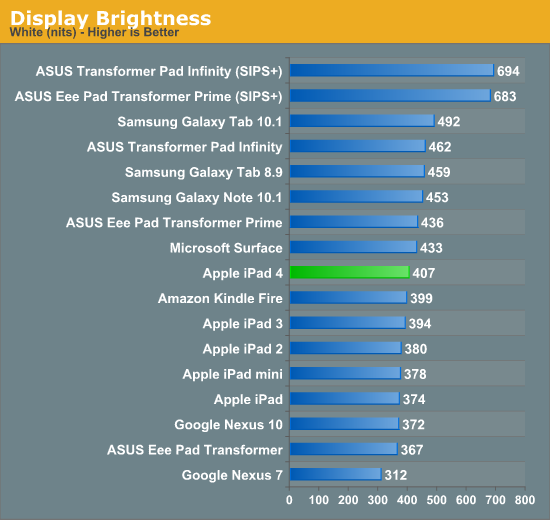
It's amazing to me that 400 nits on a nearly 10-inch display is simply middle of the pack now in modern tablets. This is just awesome. Look at any of our value notebook reviews and you'll find a bunch of displays that typically max out at sub 300 nits. It's no wonder that tablet sales are doing very well among consumers.
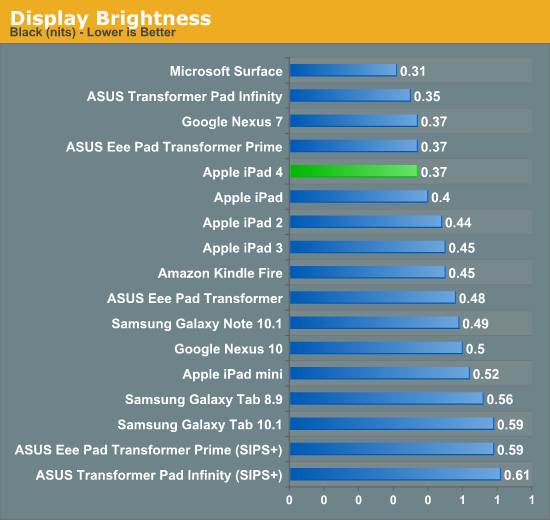
Black levels are good on the 4th generation iPad. Microsoft still holds the clear lead in black levels with its Surface RT, thanks to the tablet's bonded coverglass and display stack.
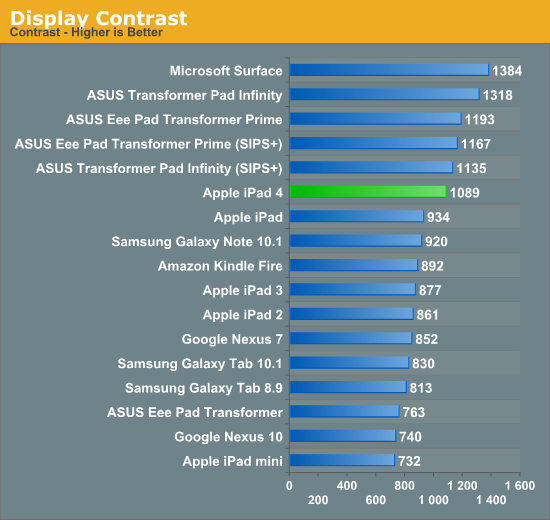
Overall contrast ratio is very good on the iPad 4. I measured a significant improvement over my iPad 3, although I suspect that has to do more with improvements to panel manufacturing than anything more deliberate.
Maintaining good brightness while pushing pixel density is only part of the equation. What made the iPad 3's display so great was that it shipped well calibrated from the factory. I assumed the same would be true for the 4th generation iPad, but I still needed to test to confirm.
To evaluate color accuracy I turned to our own Chris Heinonen's CalMAN smartphone/tablet workflow. We'll start off by looking at the calibrated white point for these tablets. What you're looking for here is a number close to 6500K:
Apple has been drifting north of 6503K for a while now. Variation in white point does seem to track well with individual panel makers in the iPad, so you may see numbers move around here depending on your luck of the draw. We've seen this in other iDevices in the past where whites will range from yellow to blue depending on what panel you end up with.
The next three charts look at accuracy represented as a difference between various source colors and what's reproduced on the display. The results are presented as average dE2000, with lower numbers being better.
First up is Grayscale performance, here we're looking at the accuracy of black, white and 19 shades of gray spread in between the two extremes:
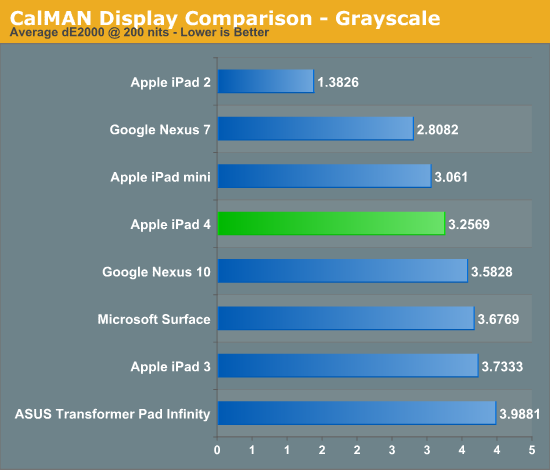
The 4th gen iPad does pretty well here, just edging out the Nexus 10 but losing to the iPad 2 and mini. Pretty much all of the tablets do a good job here at accurately reproducing grays.
First in our color accuracy tests is a saturation sweep. Here we're looking at 20%, 40%, 60%, 80% and 100% saturations of red, blue, green, magenta, yellow and cyan.
This is what you get with the iPad's pre-calibrated Retina Display: appreciably better color accuracy than any other tablet on the market today. I even measured an improvement in color accuracy compared to last year's iPad 3, however my iPad 3 was from the initial runs of production. I have noticed pretty significant variance between color accuracy between iPads. The results are always good, but some are definitely better than others.
Gamut CIE Chart
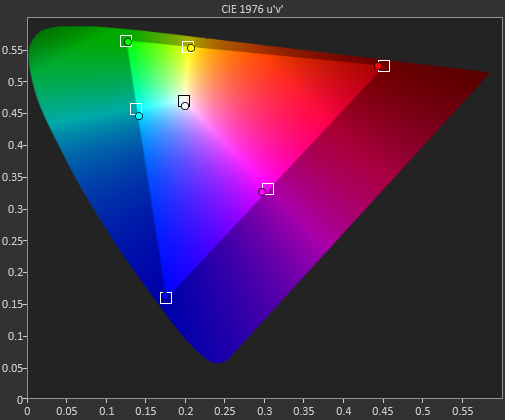
Saturation CIE Chart
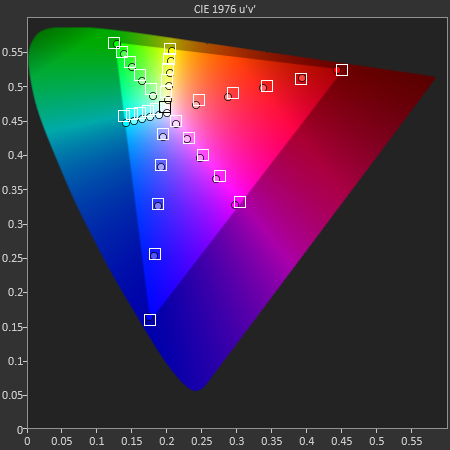
For our final accuracy test we're looking at the difference between a Gretag Macbeth colorchecker chart and the rendered swatches on these displays. Once again, lower numbers are better.
Many of the panels used here are actually good panels, the difference really boils down to calibration. Apple continues to dominate in terms of calibrated color accuracy. The 4th gen iPad's display remains the best in the industry from a color accuracy standpoint.
GMB Color Checker
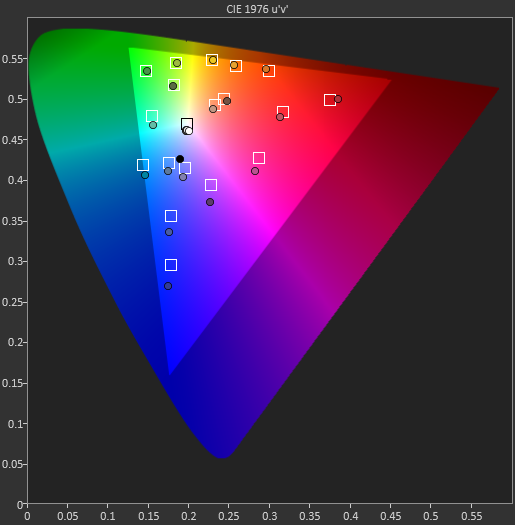



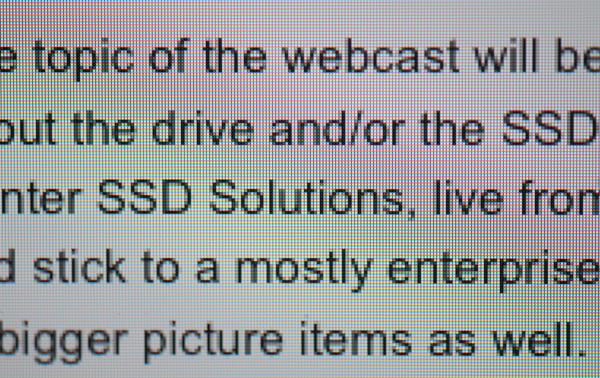
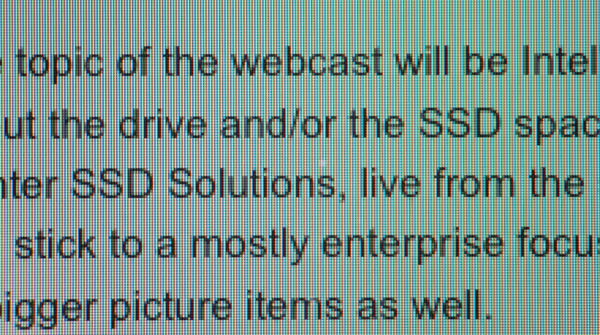
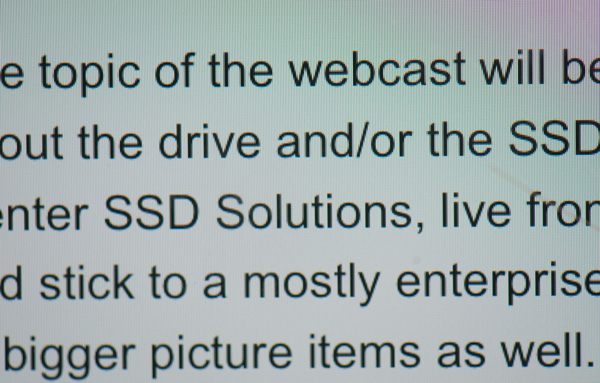
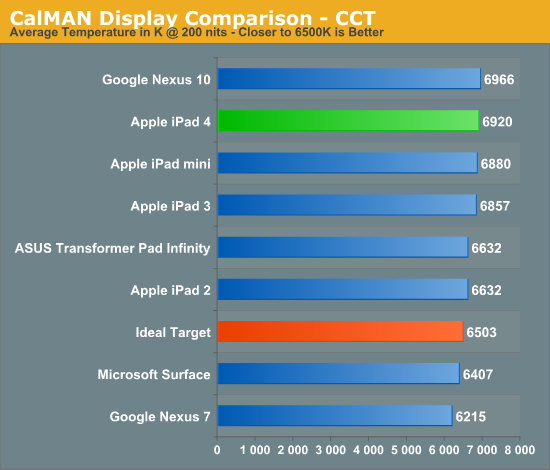
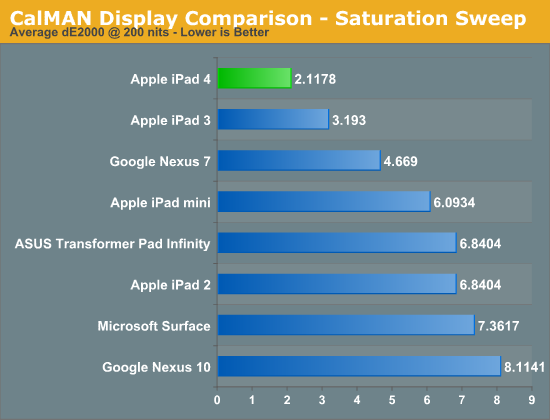
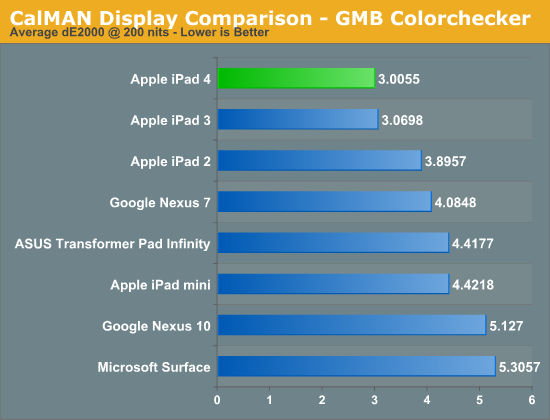








113 Comments
View All Comments
Henk Poley - Wednesday, December 12, 2012 - link
I've been thinking about getting a black and a white tablet. One for serious stuff, and one for play.Pessimism - Friday, December 7, 2012 - link
I would like to see a direct comparison review between the ipad, nexus 10, and some of the generic chinese competition with similar specs such as the zenithink c94BSMonitor - Friday, December 7, 2012 - link
Is there an App that will let me confirm which version I have of the iPad 2?? Just recently purchased during the Black Friday fury on these, so assuming the 32nm one. ThanksZink - Friday, December 7, 2012 - link
http://www.anandtech.com/show/5789/the-ipad-24-rev...Scroll down, there are free ways to do it.
Dman23 - Friday, December 7, 2012 - link
Another great, comprehensive article from AnandTech! Well down Anand!!! :DMidwayman - Friday, December 7, 2012 - link
I wish there was a PDF rendering benchmark. From what I've been able to grasp its a very CPU dependent task, but it doesn't seem to correlate well to the java benchmarks that are typically used in cpu performance tests for tablets. For example many people say the ipad line does pretty poorly here despite the good standings in the java tests. I know I'm not the only one looking at tablets as a way to view large PDF tech docs, books, etc.bogieworf - Friday, December 7, 2012 - link
My biggest issue with the iPad is that it isn't trying to be more. The advances in the 4 would inspire few with the 3 to upgrade. Contrast this with the MS Surface. The device may be successful or it may not, but at the very least, MS has attempted to re-think aspects of the tablet. Then there the Lenovo yoga 11. Again, it may not succeed (actually I have my doubts on this one), but at least Lenovo is trying out new ideas in the tablet area. Just feels like a company like Apple with its past of groundbreaking designs should be trying to do more.darkcrayon - Friday, December 7, 2012 - link
The advances and the timing of the 4 were clearly not meant to inspire "3" users to upgrade. It was just a refresh to keep it up to date with the latest SoC tech to stay near the top in performance. And notice MS put much lower end hardware in the Surface than the iPad. Tegra 3? Low resolution screen? Low resolution camera?The 5th generation iPad will surely have an updated physical design - it should be a bit lighter and have an enclosure like the mini's. But there is little wrong with the iPad's hardware, if anything the more interesting pieces will be what they will do with the software.
bogieworf - Saturday, December 8, 2012 - link
I'm looking at the big picture. The touch type cover is innovative. The integrated kick stand is a neat feature. The automatically updating Tiles in Windows 8 is a neat feature. I'm talking innovation, not just a better camera or better processor.Maybe iPad 5 will feature new innovations, maybe not. Only time will tell. But there are other companies trying new things which I presently do not see with Apple.
iCrunch - Friday, December 7, 2012 - link
Thank you. Another great review. Love the attention to every last spec!You mentioned that you couldn't find a whole lot of examples where the iPad 4's both CPU and GPU performance increases are actually noticeable, except, of course, for gaming. I have found one other area where the difference is quite evident: VNC/RDP. The iPad 4 feels several orders of magnitude faster than the iPad 3, as opposed to "just 2x". Especially when you want to remotely control your Mac at High settings, as I do! Where the iPad 3 lagged, the iPad 4 is buttery smooth. As a result, everything is more accurate when you're "VNC'ing", you make fewer mistakes, and this obviously results in a much faster and less frustrating (or more fun, whichever you prefer) experience. (I use iTeleport, btw)
As a self-proclaimed power user, everything from loading webpages (thanks to 2x2 MIMO WiFi) to downloading apps to everyday mundane tasks are noticeably faster to me.